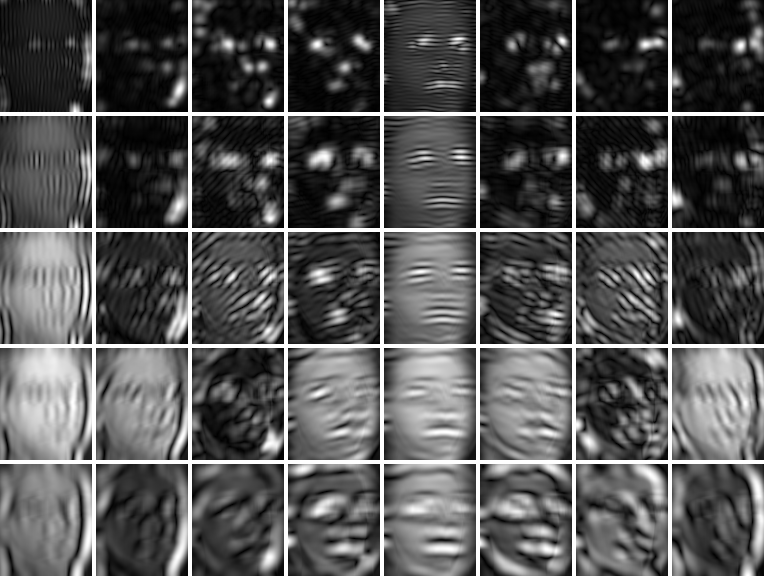最近弄人脸识别,用到Gabor卷积核,但网上的代码似乎没有和我心意的,于是参考了自己写了下!参考了Zhou Mian以及matlab的Gabor实现代码的代码。虽然OpenCV的imporc下面有个gabor.cpp,但那个是一般形式的公式,不是用来做人脸识别的,可以参考文献A review on Gabor wavelets for face recognition,又说到。上代码和链接地址!下载地址~
目前代码未经过更多的测试,不少功能为加入,但可以满足许多人的使用和参考了吧,很多人肯定非常非常需要,先开源下,欢迎指出错误之处。
Gabor.h
|
1 2 3 4 5 6 7 8 9 10 11 12 13 14 15 16 17 18 19 20 21 22 23 24 25 26 27 |
//GaborFR.h #pragma once #include "opencv2\opencv.hpp" #include <vector> using namespace std; using namespace cv; class GaborFR { public: GaborFR(); static Mat getImagGaborKernel(Size ksize, double sigma, double theta, double nu,double gamma=1, int ktype= CV_32F); static Mat getRealGaborKernel( Size ksize, double sigma, double theta, double nu,double gamma=1, int ktype= CV_32F); static Mat getPhase(Mat &real,Mat &imag); static Mat getMagnitude(Mat &real,Mat &imag); static void getFilterRealImagPart(Mat& src,Mat& real,Mat& imag,Mat &outReal,Mat &outImag); static Mat getFilterRealPart(Mat& src,Mat& real); static Mat getFilterImagPart(Mat& src,Mat& imag); void Init(Size ksize=Size(19,19), double sigma=2*CV_PI, double gamma=1, int ktype=CV_32FC1); private: vector<Mat> gaborRealKernels; vector<Mat> gaborImagKernels; bool isInited; }; |
Gabor.cpp
|
1 2 3 4 5 6 7 8 9 10 11 12 13 14 15 16 17 18 19 20 21 22 23 24 25 26 27 28 29 30 31 32 33 34 35 36 37 38 39 40 41 42 43 44 45 46 47 48 49 50 51 52 53 54 55 56 57 58 59 60 61 62 63 64 65 66 67 68 69 70 71 72 73 74 75 76 77 78 79 80 81 82 83 84 85 86 87 88 89 90 91 92 93 94 95 96 97 98 99 100 101 102 103 104 105 106 107 108 109 110 111 112 113 114 115 116 117 118 119 120 121 122 123 124 125 126 127 128 129 130 131 132 133 134 135 136 137 138 139 140 141 142 143 144 145 146 147 148 149 150 151 152 153 154 155 156 157 158 159 160 161 162 163 164 165 166 167 168 169 170 171 172 173 174 175 176 177 178 179 180 181 182 183 184 185 186 187 188 189 190 191 192 193 194 195 196 197 198 199 200 201 202 203 204 205 206 207 208 209 210 211 212 213 214 215 216 217 218 219 220 221 222 223 224 225 226 227 228 229 230 231 232 233 234 235 236 237 238 239 240 241 242 243 244 245 246 247 248 249 250 251 252 253 254 255 256 257 258 259 260 261 262 263 264 |
#include "stdafx.h" #include "GaborFR.h" GaborFR::GaborFR() { isInited = false; } void GaborFR::Init(Size ksize, double sigma,double gamma, int ktype) { gaborRealKernels.clear(); gaborImagKernels.clear(); double mu[8]={0,1,2,3,4,5,6,7}; double nu[5]={0,1,2,3,4}; int i,j; for(i=0;i<5;i++) { for(j=0;j<8;j++) { gaborRealKernels.push_back(getRealGaborKernel(ksize,sigma,mu[j]*CV_PI/8,nu[i],gamma,ktype)); gaborImagKernels.push_back(getImagGaborKernel(ksize,sigma,mu[j]*CV_PI/8,nu[i],gamma,ktype)); } } isInited = true; } Mat GaborFR::getImagGaborKernel(Size ksize, double sigma, double theta, double nu,double gamma, int ktype) { double sigma_x = sigma; double sigma_y = sigma/gamma; int nstds = 3; double kmax = CV_PI/2; double f = cv::sqrt(2.0); int xmin, xmax, ymin, ymax; double c = cos(theta), s = sin(theta); if( ksize.width > 0 ) { xmax = ksize.width/2; } else//这个和matlab中的结果一样,默认都是19 ! { xmax = cvRound(std::max(fabs(nstds*sigma_x*c), fabs(nstds*sigma_y*s))); } if( ksize.height > 0 ) { ymax = ksize.height/2; } else { ymax = cvRound(std::max(fabs(nstds*sigma_x*s), fabs(nstds*sigma_y*c))); } xmin = -xmax; ymin = -ymax; CV_Assert( ktype == CV_32F || ktype == CV_64F ); float* pFloat; double* pDouble; Mat kernel(ymax - ymin + 1, xmax - xmin + 1, ktype); double k = kmax/pow(f,nu); double scaleReal= k*k/sigma_x/sigma_y; for( int y = ymin; y <= ymax; y++ ) { if( ktype == CV_32F ) { pFloat = kernel.ptr<float>(ymax-y); } else { pDouble = kernel.ptr<double>(ymax-y); } for( int x = xmin; x <= xmax; x++ ) { double xr = x*c + y*s; double v = scaleReal*exp(-(x*x+y*y)*scaleReal/2); double temp=sin(k*xr); v = temp*v; if( ktype == CV_32F ) { pFloat[xmax - x]= (float)v; } else { pDouble[xmax - x] = v; } } } return kernel; } //sigma一般为2*pi Mat GaborFR::getRealGaborKernel( Size ksize, double sigma, double theta, double nu,double gamma, int ktype) { double sigma_x = sigma; double sigma_y = sigma/gamma; int nstds = 3; double kmax = CV_PI/2; double f = cv::sqrt(2.0); int xmin, xmax, ymin, ymax; double c = cos(theta), s = sin(theta); if( ksize.width > 0 ) { xmax = ksize.width/2; } else//这个和matlab中的结果一样,默认都是19 ! { xmax = cvRound(std::max(fabs(nstds*sigma_x*c), fabs(nstds*sigma_y*s))); } if( ksize.height > 0 ) ymax = ksize.height/2; else ymax = cvRound(std::max(fabs(nstds*sigma_x*s), fabs(nstds*sigma_y*c))); xmin = -xmax; ymin = -ymax; CV_Assert( ktype == CV_32F || ktype == CV_64F ); float* pFloat; double* pDouble; Mat kernel(ymax - ymin + 1, xmax - xmin + 1, ktype); double k = kmax/pow(f,nu); double exy = sigma_x*sigma_y/2; double scaleReal= k*k/sigma_x/sigma_y; int x,y; for( y = ymin; y <= ymax; y++ ) { if( ktype == CV_32F ) { pFloat = kernel.ptr<float>(ymax-y); } else { pDouble = kernel.ptr<double>(ymax-y); } for( x = xmin; x <= xmax; x++ ) { double xr = x*c + y*s; double v = scaleReal*exp(-(x*x+y*y)*scaleReal/2); double temp=cos(k*xr) - exp(-exy); v = temp*v; if( ktype == CV_32F ) { pFloat[xmax - x]= (float)v; } else { pDouble[xmax - x] = v; } } } return kernel; } Mat GaborFR::getMagnitude(Mat &real,Mat &imag) { CV_Assert(real.type()==imag.type()); CV_Assert(real.size()==imag.size()); int ktype=real.type(); int row = real.rows,col = real.cols; int i,j; float* pFloat,*pFloatR,*pFloatI; double* pDouble,*pDoubleR,*pDoubleI; Mat kernel(row, col, real.type()); for(i=0;i<row;i++) { if( ktype == CV_32FC1 ) { pFloat = kernel.ptr<float>(i); pFloatR= real.ptr<float>(i); pFloatI= imag.ptr<float>(i); } else { pDouble = kernel.ptr<double>(i); pDoubleR= real.ptr<double>(i); pDoubleI= imag.ptr<double>(i); } for(j=0;j<col;j++) { if( ktype == CV_32FC1 ) { pFloat[j]= sqrt(pFloatI[j]*pFloatI[j]+pFloatR[j]*pFloatR[j]); } else { pDouble[j] = sqrt(pDoubleI[j]*pDoubleI[j]+pDoubleR[j]*pDoubleR[j]); } } } return kernel; } Mat GaborFR::getPhase(Mat &real,Mat &imag) { CV_Assert(real.type()==imag.type()); CV_Assert(real.size()==imag.size()); int ktype=real.type(); int row = real.rows,col = real.cols; int i,j; float* pFloat,*pFloatR,*pFloatI; double* pDouble,*pDoubleR,*pDoubleI; Mat kernel(row, col, real.type()); for(i=0;i<row;i++) { if( ktype == CV_32FC1 ) { pFloat = kernel.ptr<float>(i); pFloatR= real.ptr<float>(i); pFloatI= imag.ptr<float>(i); } else { pDouble = kernel.ptr<double>(i); pDoubleR= real.ptr<double>(i); pDoubleI= imag.ptr<double>(i); } for(j=0;j<col;j++) { if( ktype == CV_32FC1 ) { // if(pFloatI[j]/(pFloatR[j]+pFloatI[j]) > 0.99) // { // pFloat[j]=CV_PI/2; // } // else // { // pFloat[j] = atan(pFloatI[j]/pFloatR[j]); pFloat[j] = asin(pFloatI[j]/sqrt(pFloatR[j]*pFloatR[j]+pFloatI[j]*pFloatI[j])); /* }*/ // pFloat[j] = atan2(pFloatI[j],pFloatR[j]); }//CV_32F else { if(pDoubleI[j]/(pDoubleR[j]+pDoubleI[j]) > 0.99) { pDouble[j]=CV_PI/2; } else { pDouble[j] = atan(pDoubleI[j]/pDoubleR[j]); } // pDouble[j]=atan2(pDoubleI[j],pDoubleR[j]); }//CV_64F } } return kernel; } Mat GaborFR::getFilterRealPart(Mat& src,Mat& real) { CV_Assert(real.type()==src.type()); Mat dst; Mat kernel; flip(real,kernel,-1);//中心镜面 // filter2D(src,dst,CV_32F,kernel,Point(-1,-1),0,BORDER_CONSTANT); filter2D(src,dst,CV_32F,kernel,Point(-1,-1),0,BORDER_REPLICATE); return dst; } Mat GaborFR::getFilterImagPart(Mat& src,Mat& imag) { CV_Assert(imag.type()==src.type()); Mat dst; Mat kernel; flip(imag,kernel,-1);//中心镜面 // filter2D(src,dst,CV_32F,kernel,Point(-1,-1),0,BORDER_CONSTANT); filter2D(src,dst,CV_32F,kernel,Point(-1,-1),0,BORDER_REPLICATE); return dst; } void GaborFR::getFilterRealImagPart(Mat& src,Mat& real,Mat& imag,Mat &outReal,Mat &outImag) { outReal=getFilterRealPart(src,real); outImag=getFilterImagPart(src,imag); } |
main主函数
|
1 2 3 4 5 6 7 8 9 10 11 12 13 14 15 16 17 18 19 20 21 22 23 24 25 26 27 28 29 30 31 32 33 34 35 36 37 38 39 40 41 42 43 44 45 46 47 48 49 50 51 52 53 54 55 56 57 58 59 60 |
// Win32TestPure.cpp : 定义控制台应用程序的入口点。 #include "stdafx.h" #include <vector> #include <deque> #include <iomanip> #include <stdexcept> #include <string> #include <iostream> #include <fstream> #include <direct.h>//_mkdir() #include "opencv2\opencv.hpp" #include "GaborFR.h" using namespace std; using namespace cv; int main() { //Mat M = getGaborKernel(Size(9,9),2*CV_PI,u*CV_PI/8, 2*CV_PI/pow(2,CV_PI*(v+2)/2),1,0); Mat saveM; //s8-4 //s1-5 //s1中年男人 Mat I=imread("H:\\pic\\s1-5.bmp",-1); normalize(I,I,1,0,CV_MINMAX,CV_32F); Mat showM,showMM;Mat M,MatTemp1,MatTemp2; Mat line; int iSize=50;//如果数值比较大,比如50则接近论文中所述的情况了!估计大小和处理的源图像一样! for(int i=0;i<8;i++) { showM.release(); for(int j=0;j<5;j++) { Mat M1= GaborFR::getRealGaborKernel(Size(iSize,iSize),2*CV_PI,i*CV_PI/8+CV_PI/2, j,1); Mat M2 = GaborFR::getImagGaborKernel(Size(iSize,iSize),2*CV_PI,i*CV_PI/8+CV_PI/2, j,1); //加了CV_PI/2才和大部分文献的图形一样,不知道为什么! Mat outR,outI; GaborFR::getFilterRealImagPart(I,M1,M2,outR,outI); // M=GaborFR::getPhase(M1,M2); // M=GaborFR::getMagnitude(M1,M2); // M=GaborFR::getPhase(outR,outI); // M=GaborFR::getMagnitude(outR,outI); // M=GaborFR::getMagnitude(outR,outI); // MatTemp2=GaborFR::getPhase(outR,outI); // M=outR; M=M1; // resize(M,M,Size(100,100)); normalize(M,M,0,255,CV_MINMAX,CV_8U); showM.push_back(M); line=Mat::ones(4,M.cols,M.type())*255; showM.push_back(line); } showM=showM.t(); line=Mat::ones(4,showM.cols,showM.type())*255; showMM.push_back(showM); showMM.push_back(line); } showMM=showMM.t(); // bool flag=imwrite("H:\\out.bmp",showMM); imshow("saveMM",showMM);waitKey(0); return 0; }//endof main() |
一下图片可能和程序实际运行结果有点不同,图片只是示意图,代码暂时没问题。需要考虑的是iSize大小问题,首先iSize要用奇数,然后大部分文献iSize都比较大,好像是100左右,但没看到他们描述过卷积核的大小。



 小明编程
小明编程




![[转]CVPR 2015 OpenCV 3.0 tutorial!-小明编程](https://brightguo.com/wp-content/uploads/2015/06/OpenCV-Tutorial-CVPR-2015-0-195x150.png)




